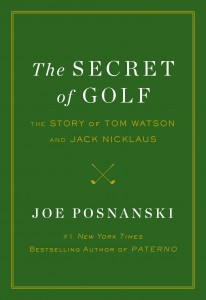The Secret of Golf: The Story of Tom Watson and Jack Nicklaus
The secret of golf is that there is no secret of golf.
That zenlike statement is what I decided was the main point of Joe Posnanski’s fine new book, The Secret of Golf: The Story of Tom Watson and Jack Nicklaus (Simon & Schuster, $27.00 SRP).
Your experience may differ, of course, so don’t take my word for it. Read it yourself and see what you think.
The book is nominally a combined sports biography of Watson and Nicklaus, paired together by history largely because of their famous “Duel in the Sun” at Turnberry, Scotland in the 1977 British Open. That tournament is a central focal point of the book, in which Posnanski nicely combines contemporary reportage, segments of the golfers’ autobiographies, and his own recent interviews of the two men.
These chapters alone make the book worth reading, but the other segments are also well done.
For example, I was a bit startled to see that the familiar story of Ben Hogan and his “secret” was the opening chapter of the book. After all, wasn’t this supposed to be all about Watson and Nicklaus, one of golf’s great rivalries of the 70s and 80s?
It later dawned on me that Posnanski was making a point about the kind of golfer who through hard work becomes extremely adept, and the level of commitment to improvement and maintaining skills that is required for most of them to stay at that level—Byron Nelson being the exception that proves the rule.
For as much as Watson became a protégé of Nelson as he entered his prime in the late 1970s, he had far more in common with Hogan when it came to his approach to practice and preparation. By comparison, Nicklaus appeared to come to the sport with far more natural ability, and was therefore a bit more like Nelson.
The other point of the Hogan story, fleshed out in subsequent chapters, is that each golfer finds his or her own way to bring out the best in their game, and that there is no single path to greatness. That’s what happened with Nicklaus and Watson, and that’s why there is no secret of golf.
The book is also a character study. In this respect it is frankly far more about Watson than Nicklaus, but that’s fine. Most golf fans are more familiar about Nicklaus and his life story than Watson, whose relationships with the media were far pricklier.
Posnanski’s own experience with Watson was better than others. He had the advantage of being the sportswriter for the Kansas City Star, and has had more extensive access to Watson.
Based on Posnanski’s descriptions, it’s hard to underestimate the influence of Ray Watson’s hard-bitten personality on molding Tom Watson’s personality. His tough love parenting, especially when it came to golf, clearly had a major impact on Tom’s own drive to perfect his game and do as well as he did on golf’s international stage. It also seems to have influenced Tom’s interpersonal skills, and not necessarily in a good way.
On the other hand, at some point in most people’s lives, the ability to explain if not excuse one’s conduct by reference to one’s parentage has to stop.
Posnanski minces few words in describing some of the less favorable parts of the Watson story, but I gather that Watson himself would not flinch from them, if asked. For example, as with many other people who find themselves in a slump, Watson sought refuge in alcohol, which as usual exacerbated the problem instead of helping to alleviate it.
Fortunately, Watson found the strength to give up drinking. That may be the best explanation for his recent resurgence on golf’s greatest stages, including his amazing performance once again at Turnberry, in the 2009 Open.
Professional golf nowadays seems to be undergoing a generational shift, with players in their teens and 20s dominating the PGA and LPGA winner’s circles. Posnanski’s book does a nice job of recalling similar generational changes in the game, from Nicklaus overcoming Palmer to Watson overcoming Nicklaus.
This is an exceptionally good book, in all its different elements. It would make a nice Christmas gift for golfers of all ages.
December 4, 2015


